It goes without saying that during the First and Second World Wars, letters were extremely meaningful. Both for those overseas serving their country and for everyone back home, they were a way of sharing news and staying connected from miles apart. Today, looking back on these letters can help us understand the feelings and experiences of the time, in a different, more personal way. In this blog, we’ll take a look at a few of these letters, and one postcard, that have made their way into the Library’s collection.
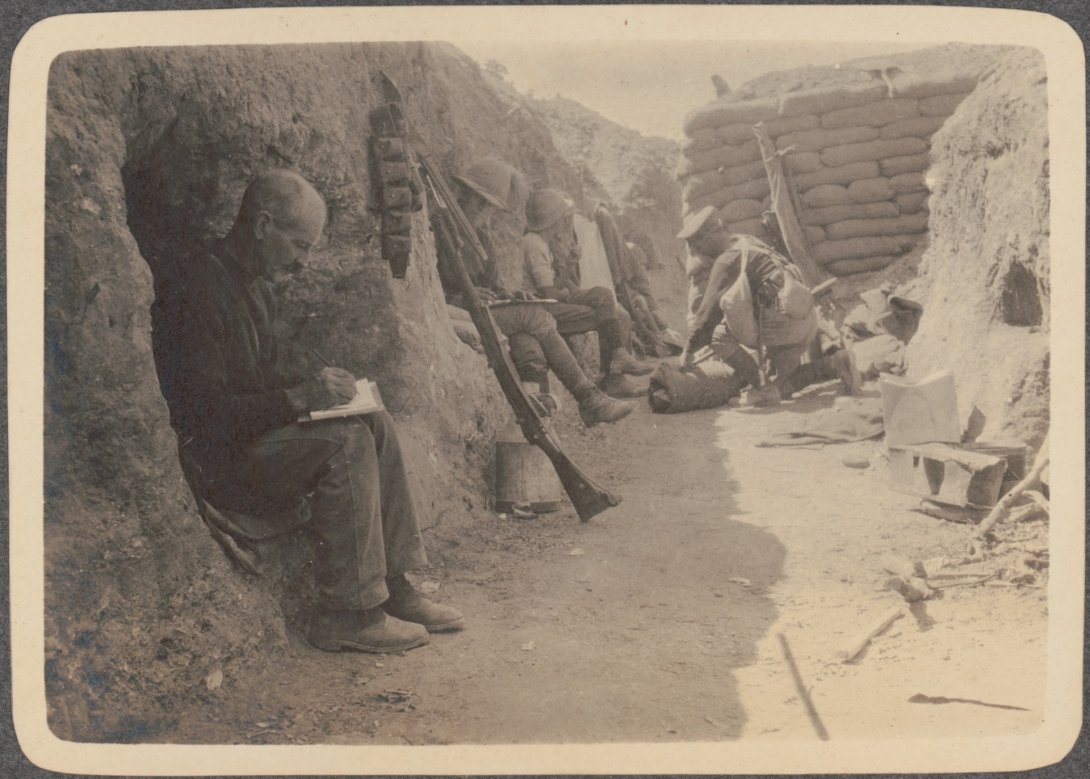
My dear daughter
Starting with a name we all recognise, we have a letter written by Andrew Barton ‘Banjo’ Paterson during the First World War. After previously working as a war correspondent during the Boer War, he initially travelled with the Australian Imperial Force (AIF) as a press representative, before making his way to France and working as an ambulance driver. He was eventually commissioned in the AIF and sent to the Middle East, where he went on to command the Australian Remount Squadron, working with horses and other animals.
The Papers of Andrew Barton 'Banjo' Paterson held at the Library include several letters written by Paterson during this time to his wife Alice, son Hugh and daughter Grace. In this letter to Grace, sent from Egypt in December 1917, Paterson shares his excitement for receiving her letter and drawings, as well as his disappointment for missing another Christmas.
We are getting near Christmas day again which will be the third Christmas I have spent away from family and it is a very dismal feeling to have Christmas coming with no friends or relations to share it with.
Viewing everything around him as equally unhappy, he goes on to say that even the animals ‘seem to be subdued and serious’ and launches into the story of a puppy he’d seen.
The only creature I ever saw trying to be festive was a little pup and he began to chase himself round and round and growl and pretend he was having a great time like puppies do and all of a sudden he caught sight of the vast inimitable stretch of desert pyramids brooding silently over it and he thought of how Moses and Napoleon and Joshua and all those people have looked on the same scene and had passed away leaving no trace behind: and no doubt it suddenly occurred to him what an ass he must look chasing his own tail round and round in such solemn surroundings and he gave himself a dismal little whimper and went and sat down in the dirt and became as serious as the rest of the living creatures about him.
I think it’s fair to say that some of these thoughts and feelings might have been his own, rather than the puppy’s.
The letter finishes with a promise to bring Grace back a souvenir from Jerusalem if he visits, his thoughts on the history of the landscape, and Christmas wishes.
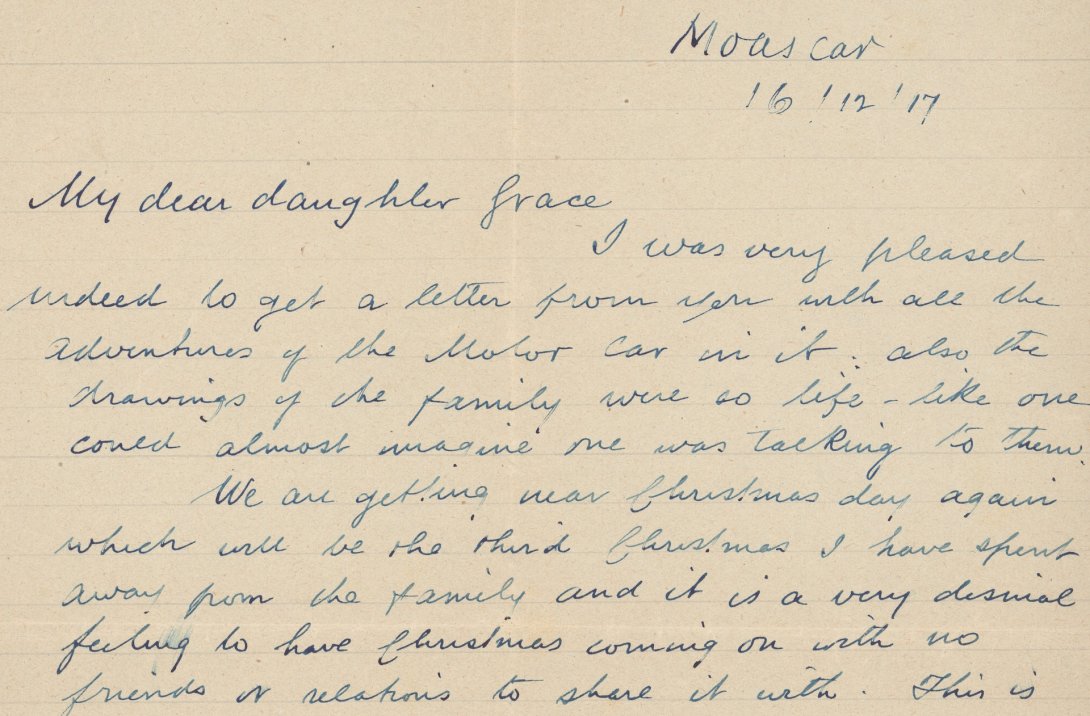
Dear Harry
Next, we have a letter sent from Don Mould to Harry Stone in February 1941. Don was one of Harry’s many teammates from the Waverley baseball club to write to him during the war and these, along with letters from Harry’s brother, make up the 72 letters in the Papers of Harry Stone.
In this letter, Don, who was working in Palestine with the Australian General Hospital medical unit, describes how he was ‘tickled pink’ to receive Harry’s last two letters.
Although we manage to get our share of general information from the daily ‘Palestine Post’ and the ‘AIF Weekly’ these rags cannot, of course, offer us the news of a more personal nature concerning the welfare and doings of our own circle of folks and, consequently, we look forward eagerly to the arrival of our letter mails.
It goes on to reassure Harry that his brother Bob, who worked as a radiology technician in the Australian Imperial Force and had recently arrived nearby, ‘was in excellent spirits and, though naturally a little strange in the new surroundings, looked fit enough to tackle anything’.
Following more updates on his work in Palestine, including how they had ‘managed to work an occasional miracle’, Don goes on to share his thoughts on the baseball happenings back home.
It is good news to hear that the ‘Ball’ season will be a fact in being again in the coming season. To my mind if the competition ceases now it will take about 5 years work afterwards to bring the game back to its position before the war... However from this distance it is not for me to judge though from experience I would like to see the control in hands other than those that now hold the reins. Not that I was ever a paragon of an executive officer but at least I could bring myself to consider the causes and effects on the game and not on a club!
While Don expresses concern that he may have ‘made my last play', newspapers show that he and Harry were back to playing baseball together shortly after the war ended, and Don went on to become the president of the NSW Baseball Union.

Sincerely yours, A. Donnell
In May 1915, Anne Donnell boarded the RMS Mooltan ship and soon sent the first of many letters to her friends and family back home while she volunteered as a nurse for the army in the First World War. Over the next few years, she wrote of her experiences in England, Egypt, Greece and France.
This letter, sent early on in her time overseas, details her journey from England to Egypt and the time she spent there, starting with boarding the Troopship Huntsgreen on 21 July 1915.
It’s all so exciting & especially when we discover we are on the [Troopship Huntsgreen] ... On Monday at 4pm we left – how quietly – not a soul on the wharf to wave a farewell. A destroyer came with us and we needed her too for we were chased by three submarines. The boys were on duty all night with their life belts on and guns in hand ... and as night comes there is not a light to be seen, they switch them off at the main and all that there is is one or two shaded lanterns. However with the morning we are in safer waters and the destroyer goes back to lead another troopship out.
After a short stop in Malta, the ship arrived in Alexandria, Egypt on 30 July and Anne expected to continue the journey to Lemnos, Greece. Soon, however, she discovered:
all sorts of things crop up by the wayside in war time and whatever comes or goes one must try and rise cheerfully to the occasion. Little did I dream when I volunteered to do my part for the boys that an odd case of midwifery should fall to my lot. My patient being Mrs Fiaschi “our colonels wife” When we arrived at Alexandria General Babtie stopped her from going on to Lemnos, the consequence was a nurse had to stay behind with her.
In the final entry of this letter, written on 23 September, Anne shares that Alexandria Elise Fiaschi was born on 11 September, and she expected to finally make her way to Lemnos in October where she stayed helping the soldiers injured on the Gallipoli Peninsula until the end of the campaign.
In 1920, Anne’s letters throughout the war were turned into a book Letters of an Australian army sister for ‘anyone who wishes for a detailed account of the life at the front’.
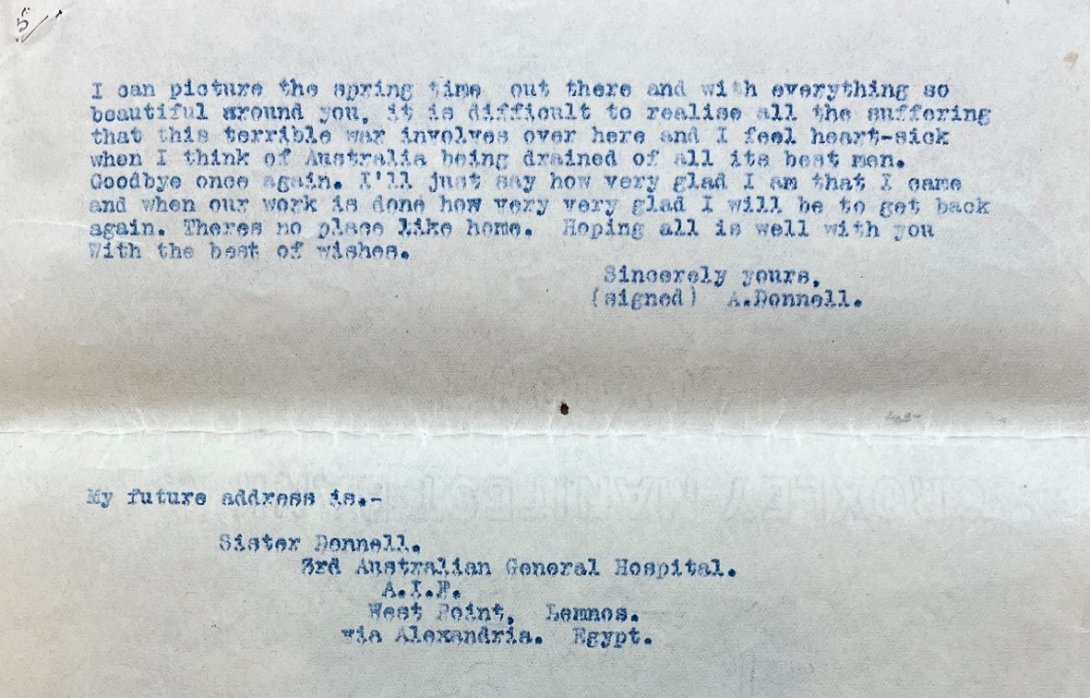
Love Pete xxx
Next, we have this letter from Air Force pilot Clement Robert Frearson, known as Peter, to Una Betty Mason, known as Betty. This is just one of approximately 380 letters sent between 1941 and 1945 in the Papers of C.R. Frearson, most of which are Peter’s letters to Betty, but also includes letters to and from their friends and Betty’s mother. Originally a frequent guest at her parents' house in Melbourne, Peter agreed to write letters to Betty when he was posted to Western Australia, and over time these regular letters went from friendly to romantic.
This letter, written on 5 October 1944, begins with Peter’s absolute joy about receiving two letters from Betty.
This day I got two long letters from the one & only, the light of my life, ... my true love, the dearest, sweetest, superdooperest angel in disguise, dream come true ... addressed to me in your own sweet handwriting. At last
Peter goes on to describe the condition of the boronia flower Betty sent to him that still ‘retains its fragrance and colour’ thanks to the grease proof paper wrapping. While he expresses regret for not thinking of doing the same for the bluebell flowers he had previously sent her, we know that they safely made their way to Australia as they eventually featured in their wedding in 1947 as part of Betty’s bouquet.
Also briefly touched on in this letter is Peter’s persistence that he is the best match for Betty. This is a recurring theme in Peter’s letters, as his friend Tom O’Shaughnessy also expressed romantic feelings for Betty. This was a point of tension in many of their letters, though in 1945 Betty made it clear that she chose Peter once and for all. Tom remained a regular figure in their lives, however, as he went on to marry Betty’s mother Lily.
The letter ends with Peter describing his ideas for their future house.
We must have a sunroom where we can have breakfast with the morning sun streaming in. Gee, won’t it be lovely, darling. I’ll be able to look across the table and see you there
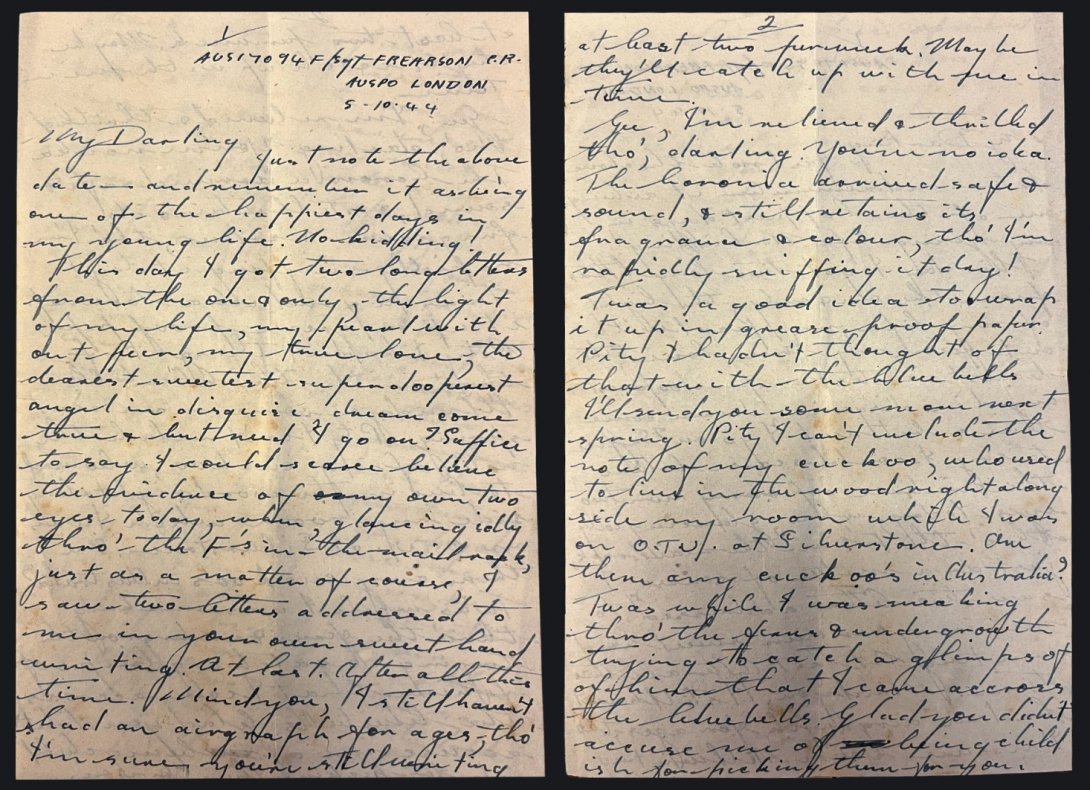
Just a few lines
Before we wrap up, let’s take a quick look at this postcard from George who is ‘somewhere in France’ to his cousin May in late 1916. One of several embroidered cards generally known as "WWI Silks" in the Jim Davidson Australian postcard collection, this card features three flowers, the colours of the French flag, tied in a similarly coloured ribbon. On the reverse, George assures May that he is grateful for the letters and papers, and that 'I am getting along alright and I am in splendid health’. Keeping it short, he briefly mentions the cold weather before closing the message with ‘love to all’.
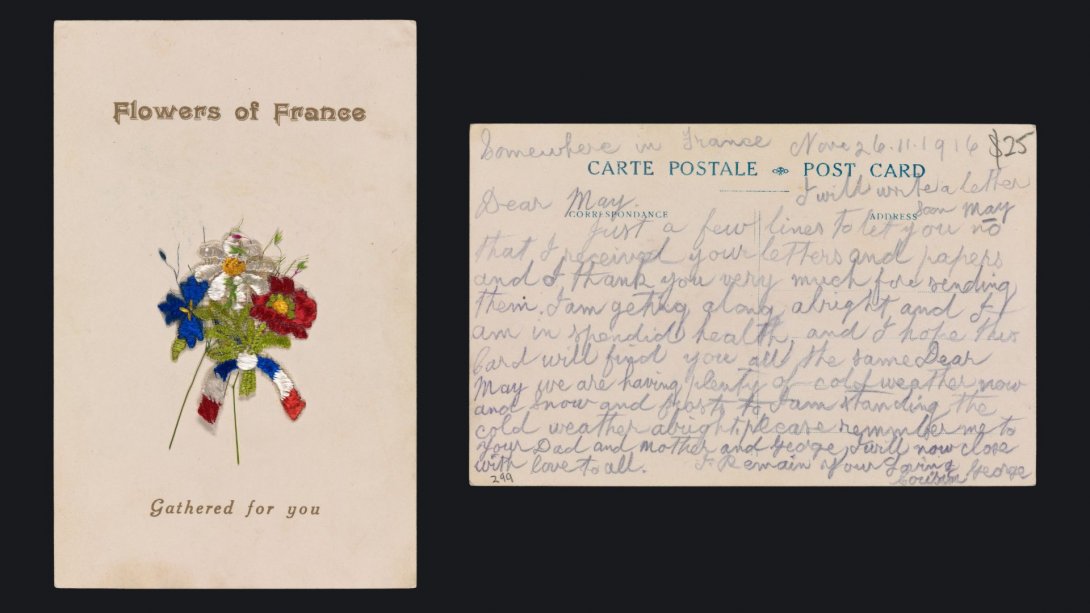
There are thousands more letters to find in the collection, start your search in the catalogue. Or if you’re interested in learning more about our material relating to the First World War, check out our research guide.